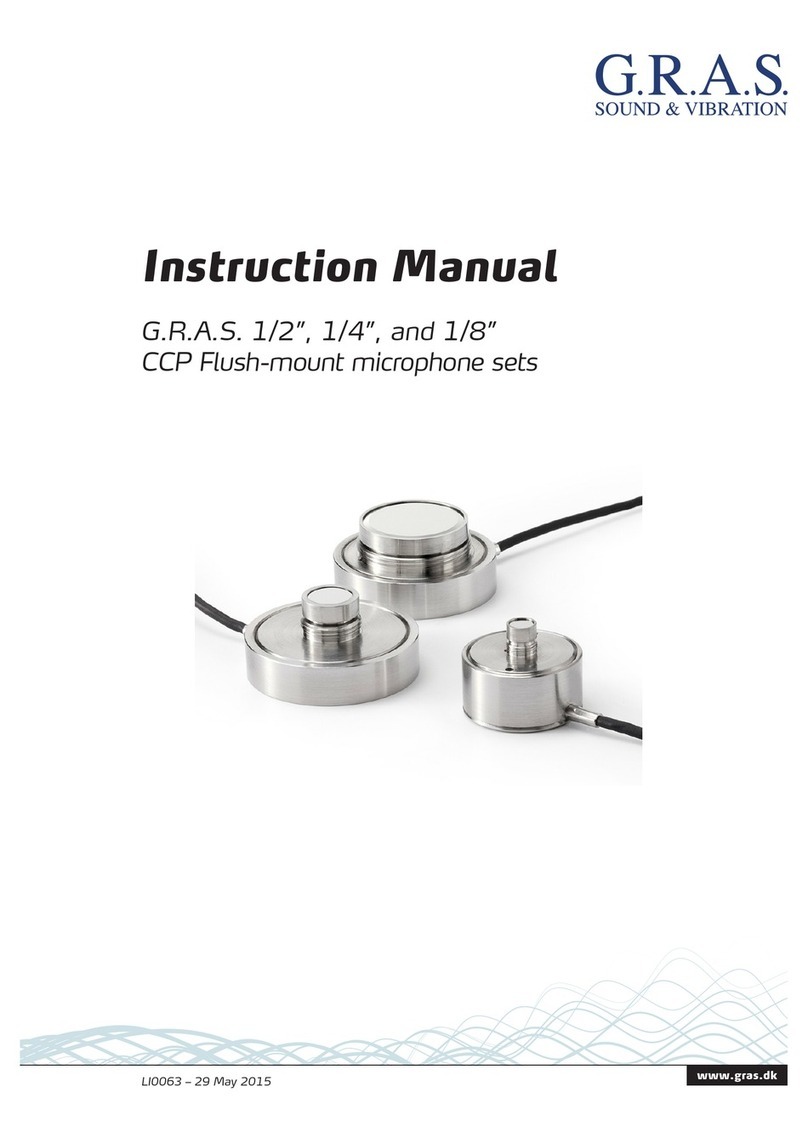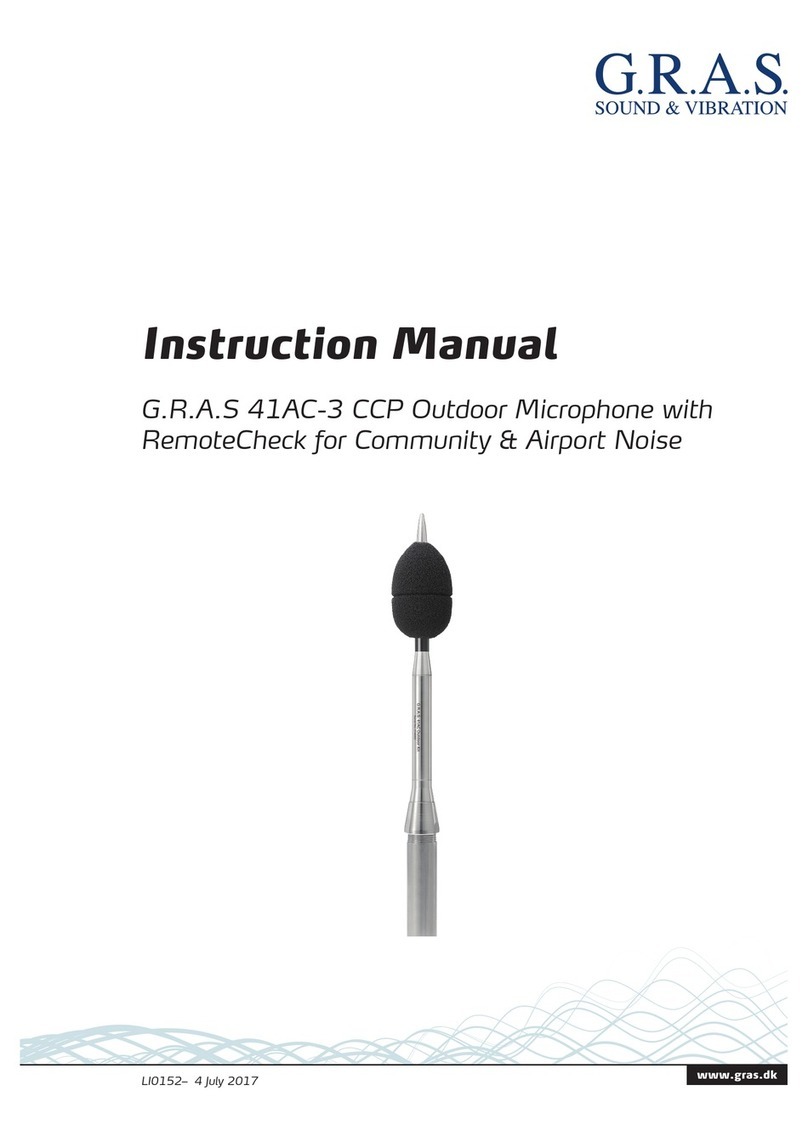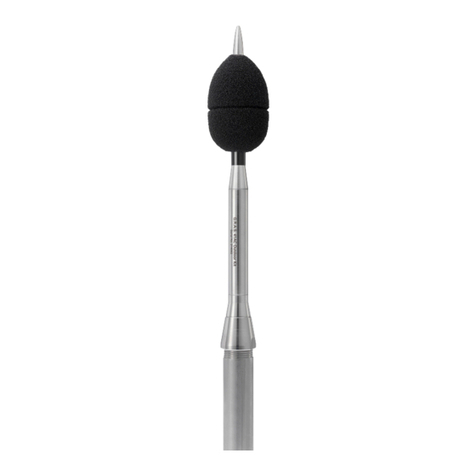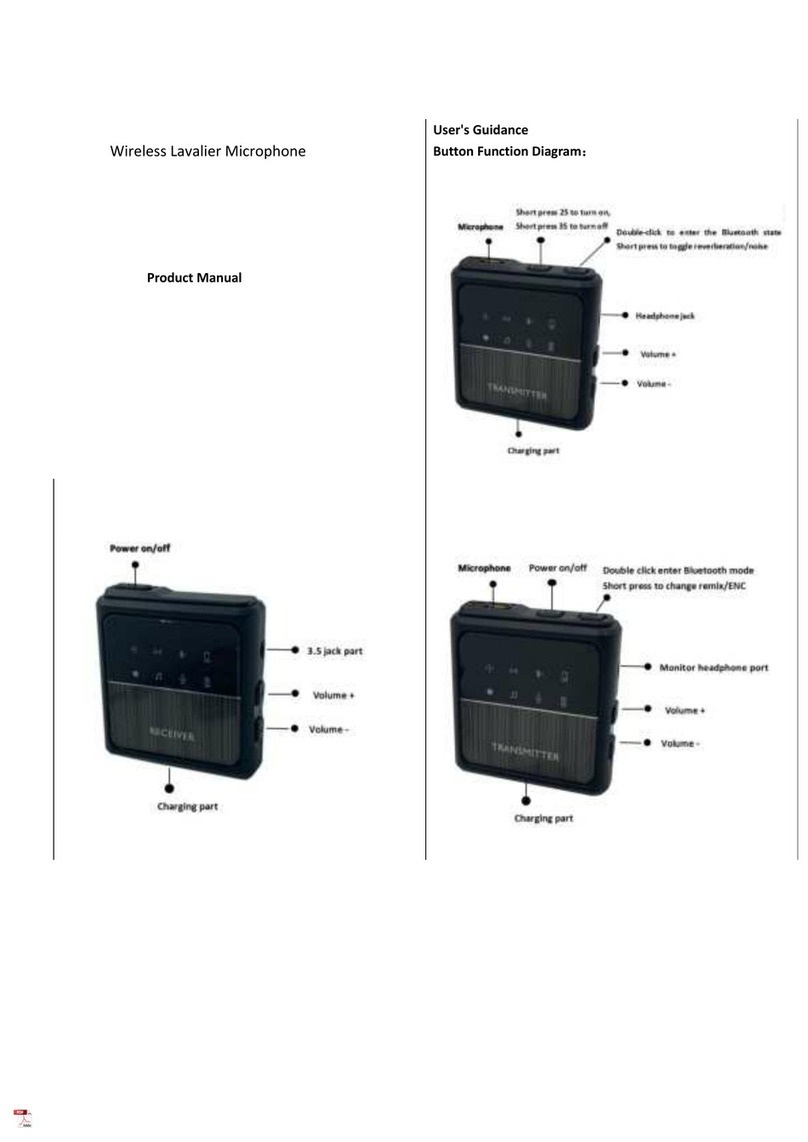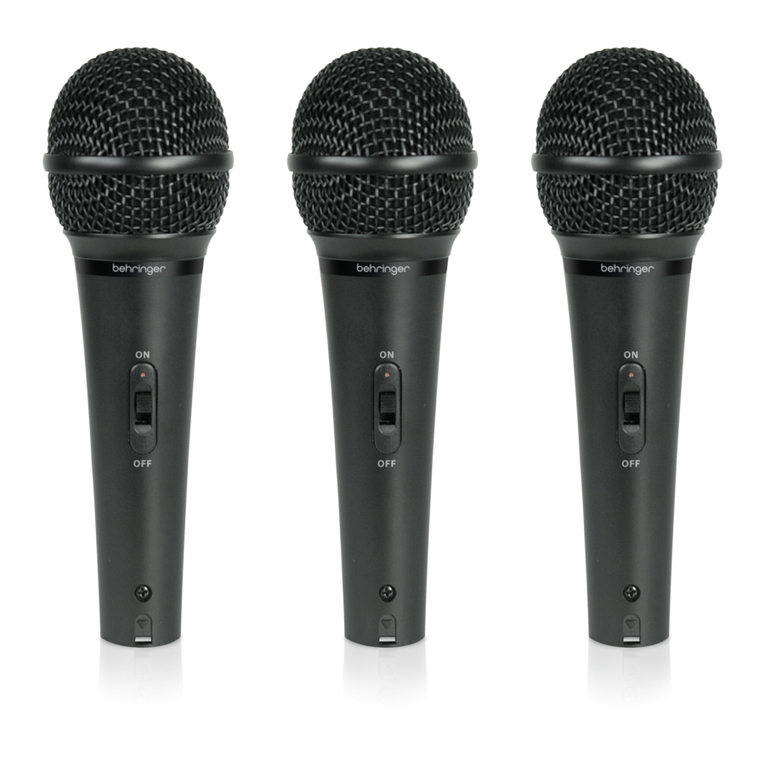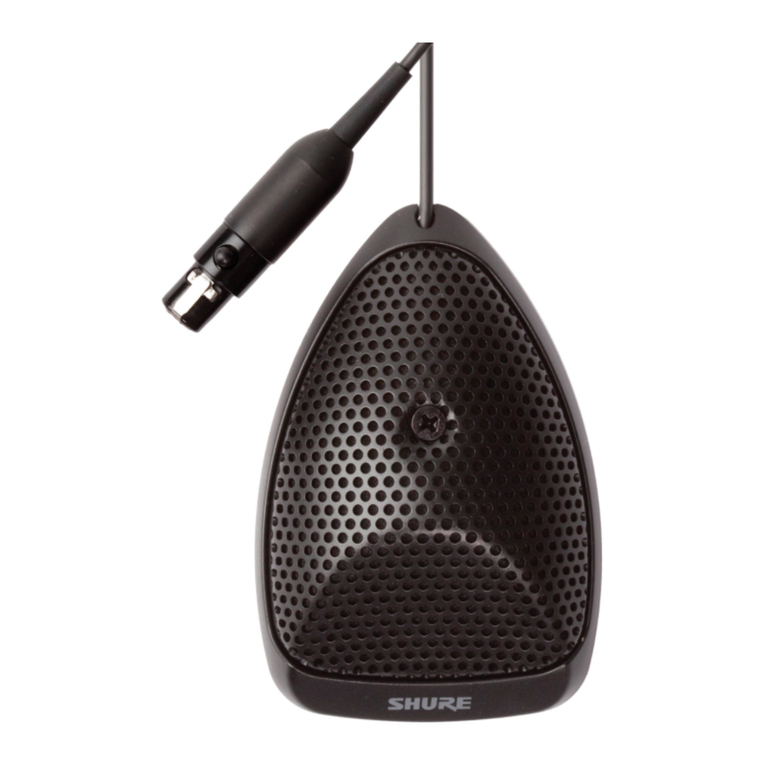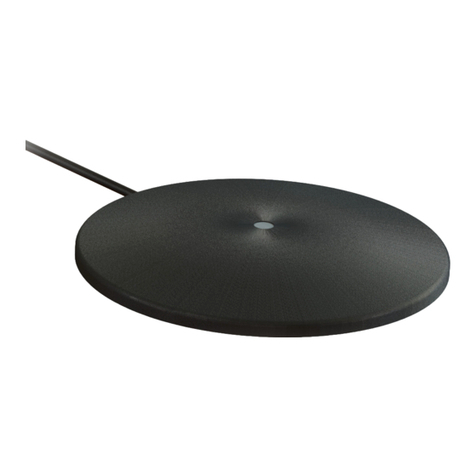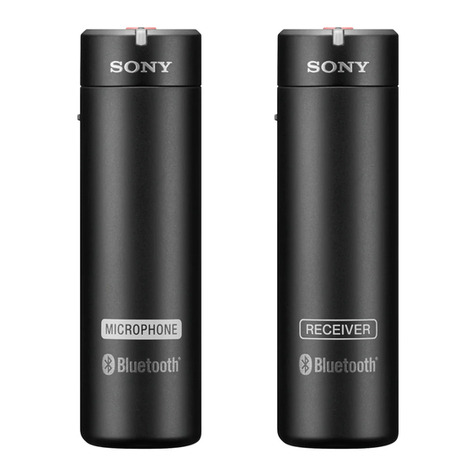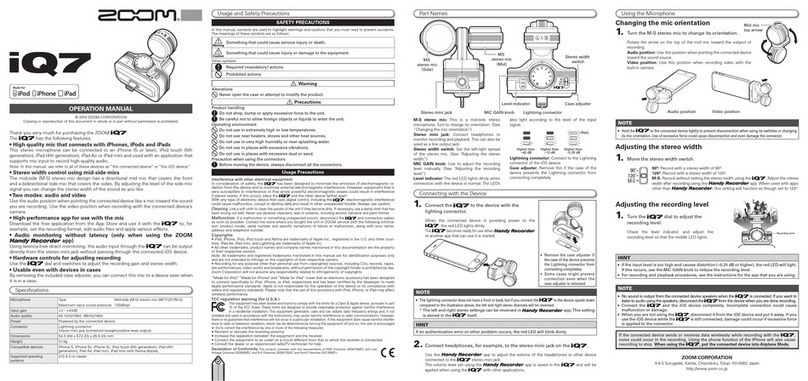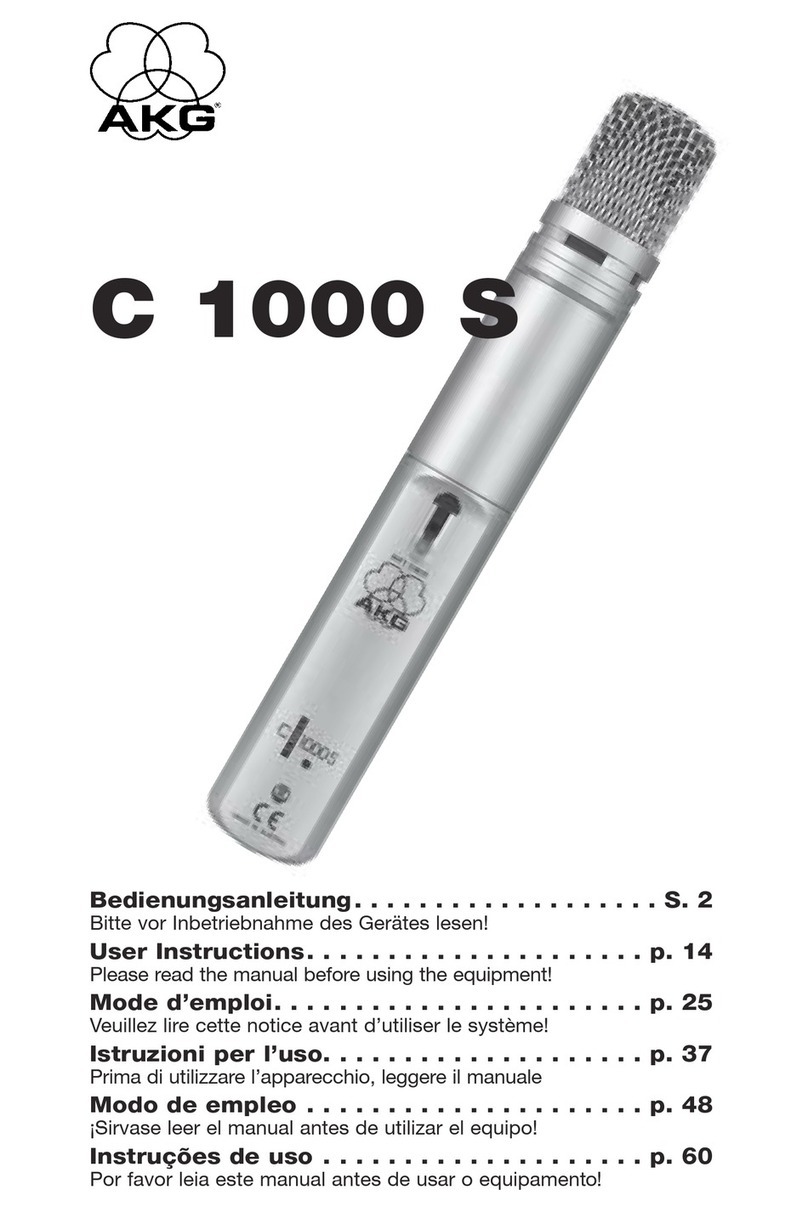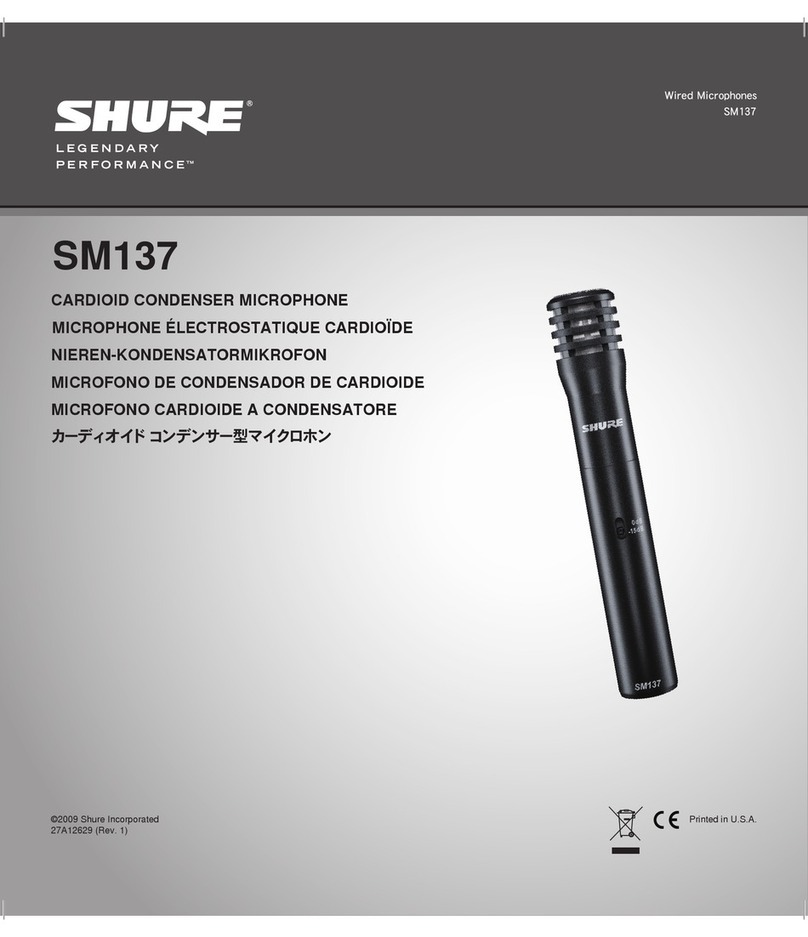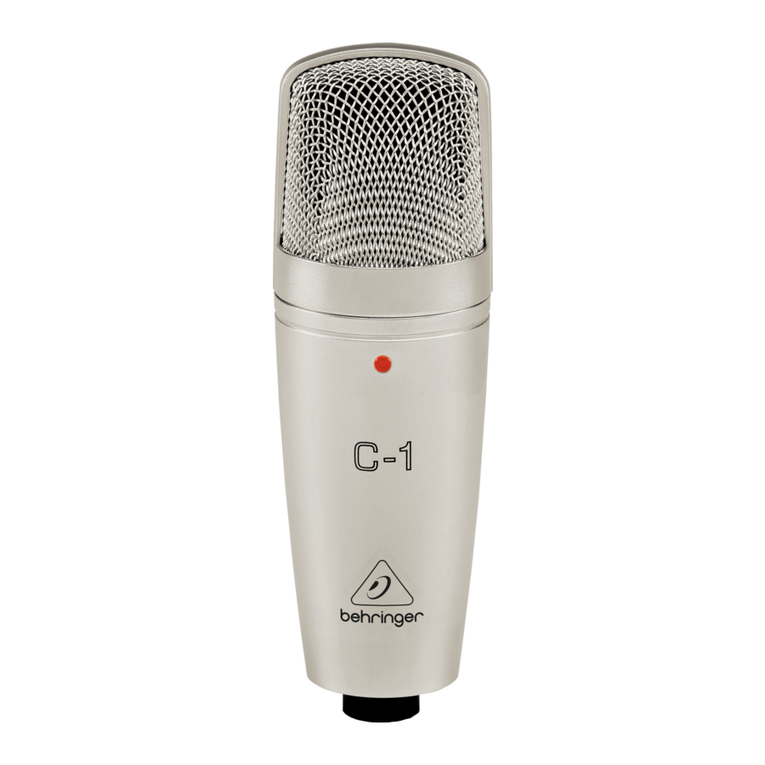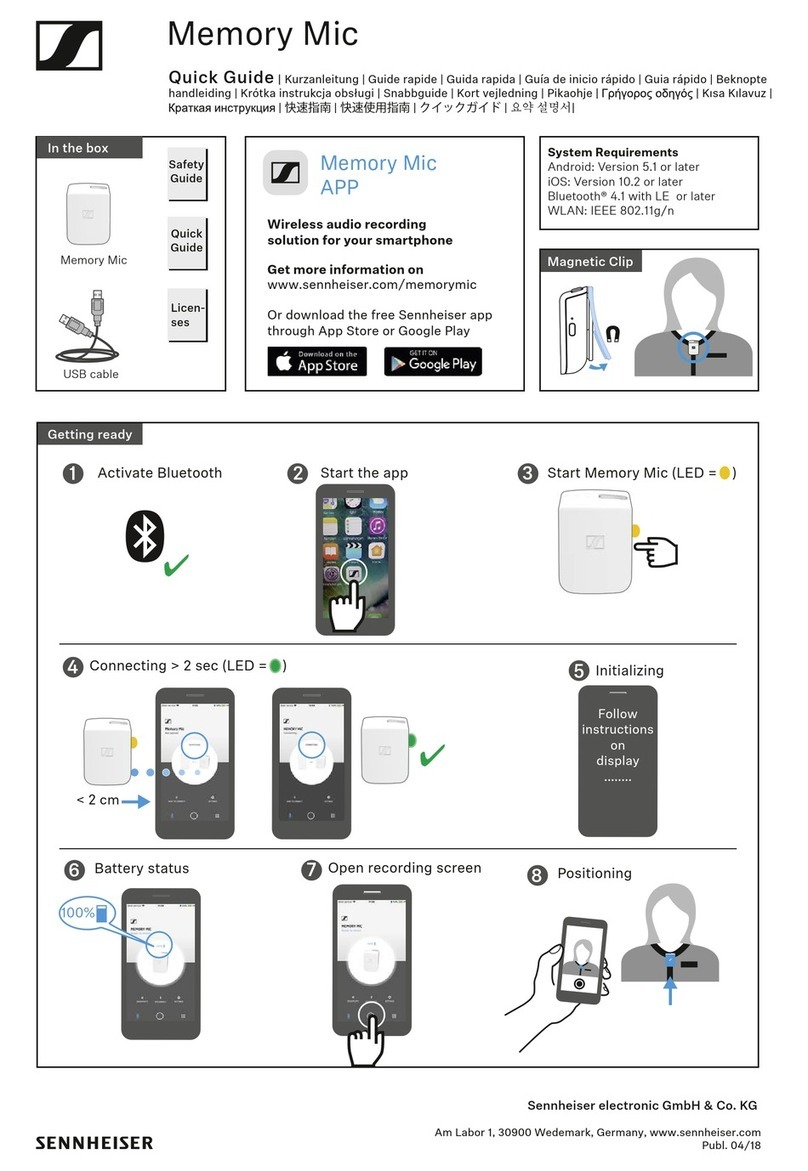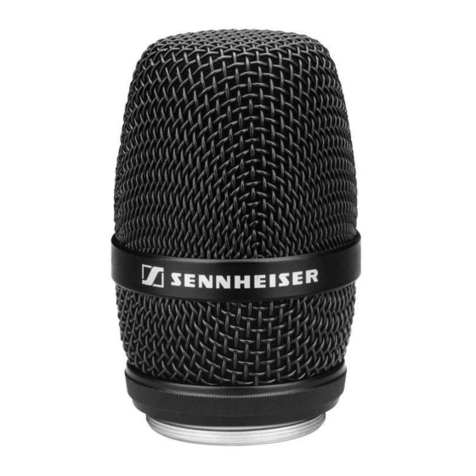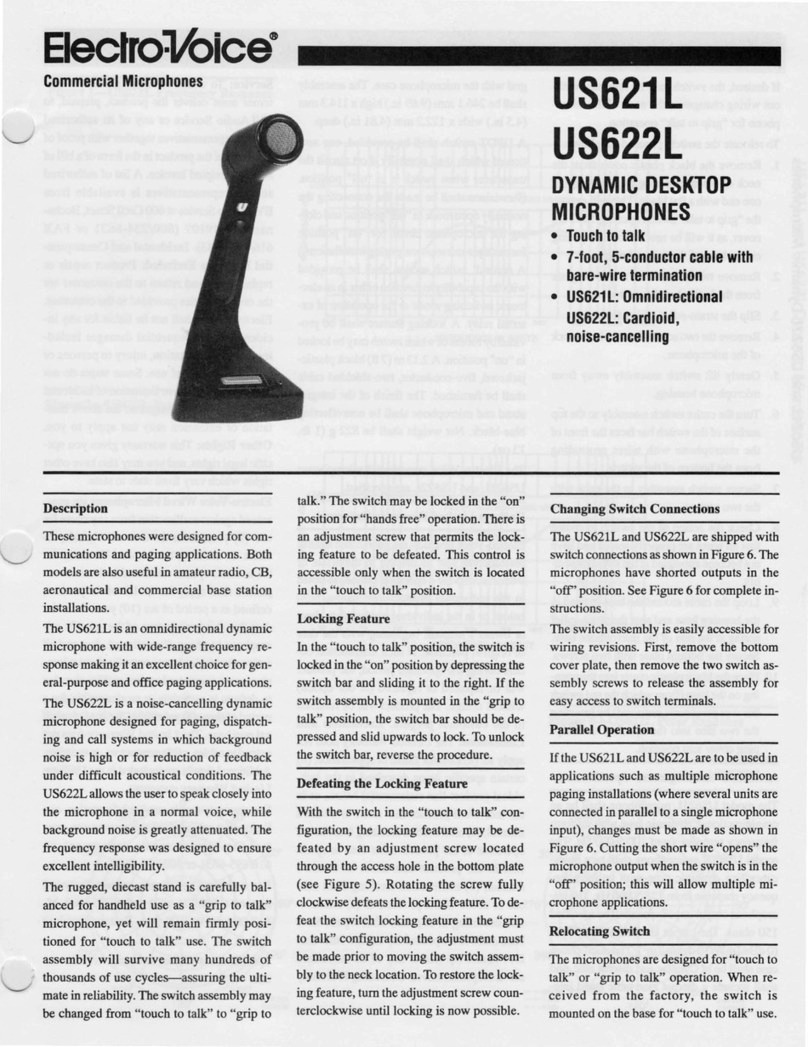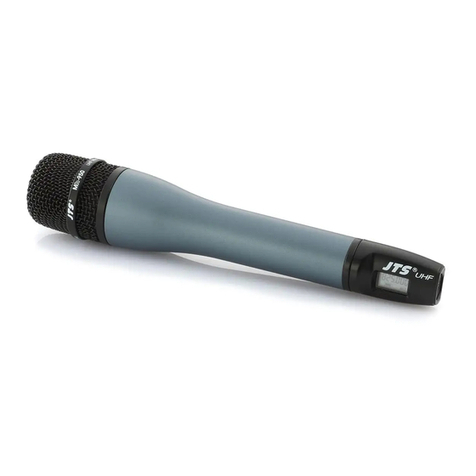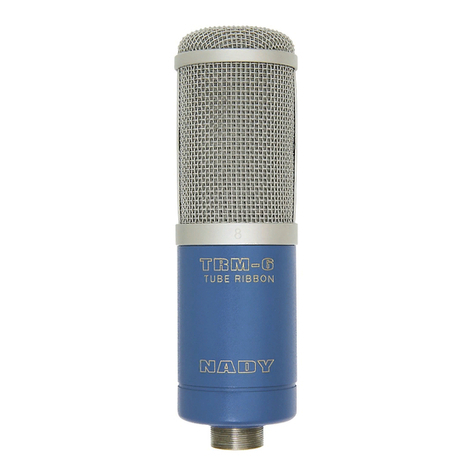G.R.A.S. 41AC-2 LEMO User manual

Instruction Manual
G.R.A.S 41AC-2 LEMO Outdoor Microphone with
RemoteCheck for Community & Airport Noise
www.gras.dk
LI0151 – 4 July 2017

2LI0151 – 4 July 2017
Revision History
Revision Date Description
1 26 August 2014 First edition
2 19 February 2015 Section about maintenance added
3 4 July 2017 42AG substituted for the obsolete 42AB
Copyright Notice
© 2014, 2017 G.R.A.S. Sound & Vibration A/S
http://www.gras.dk
Any technical documentation that is made available by G.R.A.S. is the copyrighted work of
G.R.A.S. and is owned by G.R.A.S.
The content in this document is subject to change without notice. G.R.A.S. Sound & Vibration A/S
is not liable or responsible for any errors or inaccuracies that may appear in this document.
Trademarks
Any product names mentioned in this document may be trademarks or registered trademarks of
their respective companies and are hereby acknowledged.

3
LI0151 – 4 July 2017
Contents
Introduction.................................................................................. 4
Delivered Items............................................................................. 4
Installation .................................................................................. 6
System Integration ...................................................................... 12
Maintenance .............................................................................. 13
Accessories ................................................................................ 14
Specifications ............................................................................. 14
Calibration, Warranty and Service................................................... 18

4LI0151 – 4 July 2017
Introduction
The G.R.A.S. 41AC-2 LEMO Outdoor Microphone with RemoteCheck for Community & Airport
Noise is a precision microphone set (IEC 61672-1) for monitoring community noise and the noise
of overhead aircraft.
It can be used for monitoring of noise with 90 degrees of incidence, typically community noise.
With the proper correction data, it can be used for 0 degrees of incidence, typically noise from
overhead aircraft. A USB flash drive with correction data is part of the delivery.
It is waterproof, rated at IP-55, and can operate unattended over a wide range of weather condi-
tions and temperatures for a very long period, i.e. a year or longer.
It uses a G.R.A.S. 40AF-S2 1/2” Externally Polarized Free-field Microphone, High Sensitivity and
a G.R.A.S. 26AJ 1/2’’ RemoteCheck Preamplifier with Integrated Connector.
Important. The 40AF-S2 microphone and its protective grid have been modified for the 41AC-2.
Therefore, microphone and grid cannot be replaced by standard items.
Delivered Items
1/2" Ext. Polarized Free-Field Microphone, High Sensitivity 40AF-S2
1/2’’ RemoteCheck Preamplifier with integrated connector 26AJ
O-ring for preamplifier OR2038
USB flash drive with correction data for 0° (resolution: 1/12 octave)
Wind Screen AM0378
Release Tube (for LEMO connector) GR1794
Top cone -
Upper housing -
Lower housing -
1” pole mount adapter RA0286
Tripod Adapter GR1096
Tripod thread adapter SK0017

5
LI0151 – 4 July 2017
41AC-2 is delivered pre-assembled except for the windscreen and thread adapter.
2-piece
1” pole mount
adapter RA0286
Lower housing
Windscreen
AM0378
Top cone
Preamplfier 26AJ
with RemoteCheck
Upper housing
½" microphone
40AF-S2
Release tube
Tripod and thread
adapter SK0017
O-ring OR2038
Fig. 1. The parts of 42AC-2.

6LI0151 – 4 July 2017
Installation
Mounting 41AC-2 on Tripod or Pole Mount Adapter
The 41AC-2 is designed for permanent installation and therefore comes with an adapter for
mounting on a 1” pole. See Fig. 2 and Fig. 3, 3. The 41AC-2’s housing is attached to the mount-
ing fittings with a M18 x 1.5 thread.
Two-piece pipe adapter with
1” pipe thread (ISO 228/1-G1)
M18 x 1.5
GR1096 Tripod
thread adapter
with SK0017 1/4”
threaded bushing
Tripod thread adapter
with 3/8” thread (without
bushing)
Fig. 2. The 41AC-2 lower housing’s thread and adaptors for tripod and pole mounting.

7
LI0151 – 4 July 2017
Attaching the Lower Housing
1. Unscrew the upper part from the lower body.
2. Set the upper part aside and ensure that it is protected from dirt and moisture.
3. Slide the microphone cable through the adapter and through the lower housing, and screw the
housing onto the pole mount adapter.
4. Ensure that the lower housing is properly fastened to the pole mount adapter.
23
4
1
6
5
7
23
4
1
6
5
7
1 2 3 4
Fig. 3. Attaching the lower part of the housing to the pole mount adapter.

8LI0151 – 4 July 2017
Connecting the Cable to the Preamplifier
Important. Before connecting cable and preamplifier, you must ensure that the upper housing
can turn independently of microphone, preamplifier and cable. This is done by loosening the
microphone from the preamplifier by approximately half a turn.
Doing this ensures that the microphone-preamplifier and the preamplifier-cable connections are
not subjected to strain when the upper housing is screwed onto the lower housing. Also it makes
attachment of the cable to the preamplifier safe.
1. Unscrew the nose cone.
2. Set it aside. Make sure it is protected from dirt and moisture.
3. Loosen the microphone housing by half a turn. Hold at the preamplifier connector and the
lower part of the microphone body while turning.
Important. Make sure to loosen the microphone housing and not only the protective grid!
4. Connect the cable to the preamplifier.
1 2 3 4
3
4
3
4
Fig. 4. Loosening the microphone-preamplfier: This must be done to avoid strain to the microphone-preamplifier assembly
when connecting the cable and mounting the upper part.

9
LI0151 – 4 July 2017
Mounting the Upper Housing and the Top Cone
When the microphone has been loosened from the preamplifier, you can safely mount the upper
housing onto the lower housing and subsequently mount the top cone.
1. Screw the upper part of the housing onto the lower part.
2. Fasten the microphone by turning it clockwise.
3. Screw on the top cone.
4. Ensure that the top cone is properly fastened.
1 2 3 4
6
5
6
5
Fig. 5. Mounting the upper housing and the top cone.

10 LI0151 – 4 July 2017
Mounting the Windscreen
The windscreen is glued onto a plastic tube that ensures that it can be positioned correctly:
• When pushed down, the windscreen tube is prevented from going too far by the upper hous-
ing’s conical shape.
• When the windscreen is pushed as far down as it will go, it will be kept in place by a locking
groove. Because of this, it cannot be dislocated unintentionally, and incorrect measurements
due to an incorrectly positioned windscreen are avoided.
1. Slide the tube down over the top cone.
2. Ensure that the tube is pushed as far down as it will go.
1 2
End
stop
Locking
groove
Top of microphone
(diaphragm)
Fig. 6. Mounting the wind screen. When locked in the groove, the
center plane of the windscreen will be flush with the microphone diaphragm.

11
LI0151 – 4 July 2017
Disassembly
You can disassemble the 41AC-2 by reversing the procedure described on the preceding pages.
Two points need special attention:
Removing the Windscreen
The windscreen tube is held in place by a locking mechanism. Therefore, some force must be
applied to slide the tube back up. See Fig. 7a.
1. Push at the end of the tube with a finger nail or a piece of hard plastic.
Caution. Do NOT pull at the foam as this could cause it to deform or loosen it from the tube.
Disconnecting Preamplifier and Cable
When disconnecting the cable from the preamplifier, you must push the black release tube
upwards. This will cause the LEMO connector’s locks to release.
1. Unscrew the top cone (see Fig. 7, a2).
2. Push the black release tube upwards. See Fig. 7b, 1.
3. Pull the cable downwards to disconnect it from the preamplifier. Fig. 7b, 2.
Push
3
4
1 2
A2
A2
Push
a b
1 2
Pull
Release
tube
Fig. 7. Removing the wind screen and disconnecting the cable.

12 LI0151 – 4 July 2017
System Integration
Setting the 41AC-2 for 90 or 0 Degrees of Incidence
The 41AC-2 is designed to be mounted vertically, as described in the previous sections. Mounted
in this way, it can be set up for measurement at either 90 degrees or 0 degrees of incidence.
The correction data contained on the USB flash drive that is part of the delivery must be used if
the 41AC-2 is used for 0 degrees of incidence.
The correction data are measured with a resolution of 1/12 octave.
Polarization Voltage = 200 V
41AC-2 uses an externally polarized microphone with a 26AJ 1/2’’ RemoteCheck Preamplifier
and must be connected to the LEMO input of an analyzer.
Distance to the Ground
When mounted on a pipe or tripod, the distance from the bottom of the microphone to the ground
reflecting surface must be at least 20 cm/7.9” to minimize the influence of ground reflections on
the sound field.
Replacing Microphone and/or its Protective Grid
The 40AF-S2 microphone and its protective grid are designed specifically for the 41AC-2. Only
the 40AF-S2 will ensure the stated measurement results and water protection.
Therefore neither microphone nor its protective grid can be replaced with standard items.
Calibration and RemoteCheck
Introduction
41AC-2 comes with a RemoteCheck facility that makes it possible to check the integrity of the
measurement chain remotely. RemoteCheck allows you to send a test signal from analyzer to
microphone and record the result. It works by applying a precision AC test signal (for example a 1
kHz sine wave) to an RC network in the preamplifier. This signal is applied to pin 1 of the 7-pin
LEMO cable/connector.
This method does not result in a signal proportional to the microphone’s sensitivity, but it does
give you a way to determine whether your system is stable and functional by comparing results
over time. If the newest value differs from previous values, this indicates that the system has
changed and that an error is present in the measurement chain. Note that RemoteCheck cannot
replace a proper acoustic calibration of the microphone.
Implementing RemoteCheck
Prior to implementing your RemoteCheck routine you should perform an acoustic calibration of
the 41AC-2. This will provide you with a reference and can be used to establish the relation
between calibration and subsequent RemoteCheck values. In this way you will have a more
precise knowledge of the stability of your system.

13
LI0151 – 4 July 2017
Calibration
An acoustic calibration with a pistonphone or a sound calibrator requires that windscreen and top
cone are dismantled. How to do this is shown in Fig. 7a. Calibration can be performed using a
Sound Calibrator or a Pistonphone. The G.R.A.S. 42AP Intelligent Pistonphone is recommended.
The Sound Calibrator/Pistonphone must be fitted with a coupler for ½-inch microphones.
Refer to the manual for your sound calibrator or pistonphone for further information.
Remote Check Signal Waveform and Level
The signal should be a single tone, a 1 kHz sine wave is recommended. The precision of the test
signal should reflect your requirements for accuracy.
The signal will be attenuated by about 40 dB when applied to the RC network built into the
preamplifier. Roughly speaking, a RemoteCheck signal of about 5 V RMS will result in a response
signal corresponding to a sound level of about 94 dB SPL.
When setting up your measurement system, we recommend that you – after the acoustic
calibration of the microphone – calibrate the RemoteCheck test signal. When calibrating the
RemoteCheck signal, you can adjust the signal from your generator to correspond to a desired
reading, for example 94 dB SPL.
Analysis of the Remote Check Signal
RemoteCheck verification is based on comparison of historical data from frequent RemoteCheck
measurements. Depending on the background noise level, the expected accuracy of the verifica-
tion signal will be within 0.15 dB to 0.5 dB. If the background noise is about 60 dB SPL, the
accuracy will be about 0.15 dB, if it is 70 dB SPL it will be about 0.5 dB.
To get the best possible accuracy, you must therefore monitor the background noise and select
your RemoteCheck measurement values from samples obtained in situations with low levels of
background noise. If background noise is still a problem, it can be minimized by using a larger
RemoteCheck signal and/or use a narrow band analysis around the test frequency, and in this way
you can isolate the test signal response from the background noise. In practice this should not be
necessary.
Maintenance
Depending on local conditions, the windscreen must be cleaned or replaced. How often must be
determined by visual inspection and knowledge of local weather conditions.
O-ring OR2038 (see page 5) must be lubricated with silicon grease at regular intervals.
Without lubrication it must be replaced once a year.
When under power, the preamplifier emits heat. This heat is part of the 41AC’s protection against
moisture, and therefore the power to the 41AC should be turned on permanently.

14 LI0151 – 4 July 2017
Accessories
These accessories must be ordered separately:
Intelligent Pistonphone 42AP
Pistonphone 42AA
Multifunction Sound Calibrator 42AG
3 m LEMO 7-pin - LEMO 7-pin Cable AA0008
10 m LEMO 7-pin - LEMO 7-pin Cable AA0009
30 m LEMO 7-pin - LEMO 7-pin Cable AA0012
100 m LEMO 7-pin - LEMO 7-pin Cable AA0014
Customized length LEMO 7-pin - LEMO 7-pin Cable, length in cm. AA0020-CLXXXX
Specifications
41AC-2
Dynamic range lower limit (microphone thermal noise) 17 dB(A)
Dynamic range upper limit (with 28 V/ ± 14 V supply) 138 dB
Dynamic range upper limit (with 120 V/ ± 60 V supply) 144 dB
Set sensitivity @ 250 Hz (±2 dB) 50 mV/Pa
Compliance IEC 61672-1
Polarization voltage 200 V
Power supply 28 V to 120 V /± 14 V to ± 60 V
Power consumption 0.7 mA (± 14 V) / 2.3 mA (± 60 V)
Temperature range, operation -30 to 70 / -22 to 158
Connector type 7-pin LEMO
CE/RoHS compliant/WEEE registered Yes/Yes/Yes
Water Resistance IP55

15
LI0151 – 4 July 2017
RemoteCheck
Signal waveform Sinusoidal
Test frequency to be used 750 to 1000 Hz
Amplitude 5 to 50 V RMS
Repeatability (depending on background noise) 0.15 dB to 0.5 dB
0 V
RemoteCheck
Fig. 8. 7-pin LEMO 1B male connector (external view) on the 41AC-2s preamplifier and output cable. The RemoteCheck
signal is applied to pin 1.
295 mm/11/ in
343 mm/13/ in
12 mm// in
1”pipe thread (ISO 228/1-G1)
Fig. 9. When mounted on a pipe, the top of the 41AC will be elevated 343 mm above the pipe.

16 LI0151 – 4 July 2017
Frequency Response and Directional Response
-20
-15
-10
-5
0
5
1000 10000
dB
Frekvens
41AC
Typical frequecy responce
90° incidence
0° incidence
0° incidence with correction
IEC expanded lim+
IEC expanded lim-
IEC lim +
IEC lim -
0° incidence
0° incidence with corr.
IEC 61672-1 tolerance +
IEC 61672-1 tolerance -
90° incidence
Typical Frequency Response
Frequency [Hz]
Amplitude (dB)
IEC 61672-1 accept. limit +
IEC 61672-1 accept. limit -
Fig. 10. Typical frequency response.
0
0,5
1
1,5
2
2,5
3
3,5
4
4,5
5
1000 10000
Acceptance limits for deviations of directional response
41AC w. windscreen
0º incidencs Lim dev ±30º
0° incidence
90° incidence
Lim w. uncertanty ±30º
Lim dev ±30º
Frequency [Hz]
Amplitude (dB)
±30° Directional Response Measurements
0° and 90° Incidence
0° incidence
90° incidence
IEC 61672-1 tolerance
IEC 61672-1 acccept. limit
Fig. 11. ±30˚ directional response at 0° and 90° incidence.

17
LI0151 – 4 July 2017
Frequency [Hz]
Amplitude (dB)
0
2
4
6
8
10
12
14
1000 10000
Acceptance limits for deviations of directional response
41AC w. windscreen
0º incidence Lim dev ±90º
0° incidence
90° incidence
Lim w. uncertanty ±90º
Lim dev ±90º
±90° Directional Response Measurements
0° and 90° Incidence
0° incidence
90° incidence
IEC 61672-1 tolerance
IEC 61672-1 acccep. limit
Fig. 12. ±90˚ directional response at 0° and 90° incidence.
0
2
4
6
8
10
12
14
16
18
20
1000 10000
Acceptance limits for deviations of directional response
41AC w. windscreen
0º incidence Lim dev ±150º
0° incidence
90° incidence
Lim w. uncertanty ±150º
Lim dev ±150º
Frequency [Hz]
Amplitude (dB)
±150° Directional Response Measurements
0° and 90° Incidence
0° incidence
90° incidence
IEC 61672-1 tolerance
IEC 61672-1 acccept. limit
Fig. 13. ±150˚ directional response at 0° and 90° incidence.

18 LI0151 – 4 July 2017
Calibration, Warranty and Service
Calibration
Before leaving the factory, all G.R.A.S. products are calibrated in a controlled laboratory environ-
ment using traceable calibration equipment.
An individual test certificate stating the sensitivity and frequency response is included with each
product.
Warranty
All G.R.A.S. products are made of high-quality materials that will ensure life-long stability and
robustness. The 41AC-2 is delivered with a 5-year warranty.
The windscreen comes with a 6-month warranty, this warranty covers defective workmanship only
and not the effects of normal use.
Damaged diaphragms in microphones can be replaced.
The warranty does not cover products that are damaged due to negligent use, an incorrect power
supply, or an incorrect connection to the equipment.
Service and Repairs
All repairs are made at G.R.A.S. International Support Center located in Denmark. Our Support
Center is equipped with the newest test equipment and staffed with dedicated and highly skilled
engineers. Upon request, we make cost estimates based on fixed repair categories. If a product
covered by warranty is sent for service, it is repaired free of charge, unless the damage is the
result of negligent use or other violations of the warranty. All repairs are delivered with a service
report, as well as an updated calibration chart.
WEEE directive:
2002/96/EC
CE marking directive:
93/68/EEC
Manufactured to conform with:
RoHS directive:
2002/95/EC
G.R.A.S. Sound & Vibration continually strives to improve the quality of our products for our customers; therefore, the
specifications and accessories are subject to change without notice.
Table of contents
Other G.R.A.S. Microphone manuals
